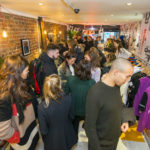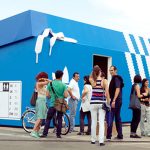Highsnobiety discusses the best ways to plan a pop-up shop with the director of Storefront UK, Matthew Greenwell. The article covers everything from finding the right space, to deciding how long the pop-up should run, and differentiating between sales and street cred when choosing a locale. Here’s the full High Snobiety article to learn about planning your pop-up store:
Here at Highsnobiety, we’re committed to bringing relevant, practical information to our readers to help them break into creative industries, launch their own businesses, and live their best possible lives. Today, we’re taking a look at how to plan a pop-up store.
Discussions about retail these days are often tough. Newspapers talk about the death of the high street, retailers struggle to compete with online outlets and shoppers are savvier to the wider choice available to them through other platforms. As has happened with many other industries before it, retail has had to confront the weaknesses in its model and work toward finding a new, better way of doing things. When things get tough, it’s time to shake it up.
Such a situation isn’t always doom and gloom, though. In fact, it’s precisely this scenario that has forced brands, retailers and indeed all other sections of the industry to become more dynamic. It’s no longer good enough to open a store, buy some stock and wait for footfall; nor can a brand just go to a tradeshow, open a few accounts and wait for the orders to come flooding in.
Everybody’s had to become a jack of all trades. Stores are now creating their own content, lookbooks and social materials. Brands are reaping the benefits of direct-to-consumer sales, cutting out the middleman altogether and strengthening their relationship with their customer. Factories are becoming more responsive to the needs of their clients: if product X is selling well and the brand needs 50 more pieces, it’s increasingly easy (and indeed, necessary) for a manufacturer to turn on a dime and get fresh product out there.
The point is that fashion retail and the art of selling is more about dynamism than ever, and nowhere is this better demonstrated than the pop-up shop. It’s now possible for a start-up label to set up shop for weeks, even days, and see how their product performs in the real world, or for larger brands to explore new territories or present their brand in a different light. Though the primary function will always be selling product, the pop-up shop is actually a vital tool that, if done correctly, can be as much a learning experience or research tool as an opportunity to make money.
But that proviso, “if done correctly,” is a big one, and if you’re thinking of organizing your own pop-up store, there’s a number of things to consider. Storefront is an online company that’s bringing the Airbnb model to the retail world, connecting brands big and small with retail spaces around the globe, previously working on projects including the Nike x Riccardo Tisci launch in New York, a Happy Socks pop-up event on London’s famous Portobello Road, and Kanye West’s notorious The Life of Pablo Tour pop-up store.
Put simply, they know what makes a successful pop-up event. We spoke to Storefront’s Director, Matthew Greenwell, about what to consider when planning a pop-up shop, and this was his key advice:
What Is Your Objective?
Thomas Welch / HS
Though selling product is the primary goal, a pop-up shop can work towards a number of goals, provided you know what they are. “Brands have different goals when launching a pop-up,” Matthew explains. “Some are looking to strengthen their brand by hosting an interactive, immersive event, while others hope to test ideas, new products or learn more about their customer.”
“For a smaller brand, it can be a stepping stone to test an idea in the physical world, while larger brands are now using them as long as 18 months to test out a new location or market,” he continues. Start by understanding what it is you hope to achieve, that way you can make sure that every decision you make afterwards leads toward that goal.
Find the Right Space
There’s a reason every Supreme store has the same parquet flooring, galvanized steel rails and clean, white walls. They’ve created a visual language that ties in with the product, turning the whole store into an experience.
The same should be true of your pop-up. “You know your brand better than anyone. The space you choose should mesh visually with your brand and look like an extension of your website, if you have one. Think about it: if you owned a vintage clothing e-store, would it make sense for you to rent a corporate event space for your pop-up?”
“Also, before you start your search, make a list of the things you want your space to have, and then identify things you might be able to work around (like poor lighting) with absolute deal breakers (like no Wi-Fi). Most importantly, think about size: if the space is too big, you risk diminishing the impact of your product; if it’s too small, you’ll end up with everything crammed on a rail, which isn’t a good look. Ask yourself what extras you might also need, such as storage space for stock, changing rooms or windows for a window display.”
Cool Is Good, but Sales Are Better
Emanuele D’Angelo / HS
Just because it’s a trendy part of town, doesn’t mean it’s where the shoppers are. If you want to sell well, choose a place where people are shopping — especially those who might not be familiar with your brand. As Matthew explains, “A street such as Red Church Street in Shoreditch has lots of East London cred, but has much lower foot traffic than a busy neighborhood like Covent Garden.”
Translation: you end up paying a premium for a trendy spot with barely any customers during the week. If you do want to take a risk, take people by surprise: “Sometimes a pop-up that doesn’t normally belong in a particular area will attract the most attention and the sales that come with it.”
How Long Do You Want to Run For?
Thomas Welch / HS
When it comes to timing, finding the right balance is key. A shorter time period could mean greater exclusivity and a “get it before it’s gone” vibe, but you don’t want to pack up after one weekend with a load of unsold stock.
On the other hand, if you’re testing the market, you won’t get the full picture without an idea of how a typical month pans out. “One of our fastest growing customers segments is medium-size brands and retailers,” Matthew says. “They’re ditching the idea of opening that third or fourth permanent location and instead choosing two or three six-month pop-ups in different international cities.”
“This allows them to test the brand in each city and they can do it all inside the space of a year, which is incredible,” Matthew continues. “On the opposite end of the spectrum, the “get it before it’s gone” formula works! Our data shows that brands will make an average of 5.6 times more in sales per square foot in pop-up space against a traditional long term store.”
Promotion Is Key
Dominik Schulte / HS
A pop-up store is no good if nobody knows about it. Use social media, mailing lists and PR to advertise your pop-up before the event: too soon and people will forget, too late, and it’ll pass them by.
“It really is important for brands to build a buzz up to the event, market it while live and followup when it’s finished. We recently launched a pop-up with Kodak in Soho to promote their new camera smartphone, and promotion was consistent throughout; using traditional marketing like press and mailouts in the build-up, then while the event was live Kodak hosted various workshops and interactive events that were broadcast on Instagram and Snapchat stories. Even if one of your customers isn’t able to attend, there’s plenty ways to give them a piece of the action.”
Kick Things off with a Launch Event
Thomas Welch / HS
You’re new in the neighborhood, so why not throw a party? Launch events are a great way to entice new customers, make an impact and create the perfect opportunity for press and local trendsetters to put the spotlight on your brand. Self-promotion is great, but getting other people to do it for you is better. Matthew explains:
“People care about the story behind a brand. Where did it start? Who founded it? What are its influences? Increasingly people are buying into real experiences and local connections over big national marketing campaigns. If they like you, they may become a customer for life and be your biggest advocate. These are the types of people that will tell their friends about you and build a genuine buzz around your brand.”
Make It Make Sense
Dominik Schulte / HS
Great pop-up stores have a concept or theme, and stick to it. Identify your brand, understand what it is that makes you you, and use this opportunity to bring that identity to life. From layout, to logo, to decorations, to product, tell people a story and create a world they can immerse themselves in:
“Whether your brand is built around a deep intricate story or simplicity is more your style, you need to make sure your pop-up theme is understandable and makes sense to your customers. Keep it simple, even if you have lots going on in your store. Make sure your store resonates with your brand rather than trying to reinvent what you are about, otherwise you may just confuse people.”
Take Notes and Reflect on the Results
Dominik Schulte / HS
Once it’s all over and the shop’s packed up, it’s easy to kick back and celebrate a finished project, but this is where the real work begins. How did you sell? Which products performed best? What kind of people bought stuff? What aspects of the store got the best response? How can you take this insight and use it to push to the next level?
“In the retail world, data is king,” Matthew says. “A pop-up store is your golden opportunity to collect insightful quantitative and qualitative data to help you plan for the future. Focus on what sold best and develop the areas that your customers liked most.”
“However, it’s also important to focus on the negatives. Did you get any bad feedback on the way your brand manufactures its products or acts on social media? What did you customers talk most about? Listen to them and then move on a more informed, smarter path.”
- Pop Up 101: How To Design Your Pop-Up Store Layout - September 7, 2020
- 5 Reasons Why Your Brand Should Host a Holiday Pop-Up Store - December 10, 2017
- 4 Ways To Capitalize On The “Retail Crisis” in NYC - August 4, 2017













